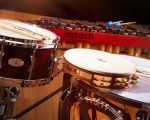How to Make Music on a Laptop Without Instruments
Creating music without traditional instruments might seem like a daunting task, but thanks to modern technology, it's easier than ever to make music right from your laptop. Whether you're a complete beginner or someone with some experience looking to explore new methods, this guide will walk you through how to make music on a laptop without any physical instruments. In the digital age, your laptop can become a powerful music production studio, capable of creating impressive tracks that rival anything recorded in a professional studio.
1. The Power of Digital Audio Workstations (DAWs)
At the heart of creating music on your laptop lies the Digital Audio Workstation (DAW). A DAW is a software application used for recording, editing, mixing, and producing audio files. Some of the most popular DAWs for laptop music production include Ableton Live, FL Studio, Logic Pro X, and GarageBand. Each of these programs has its own unique set of features, but all offer the tools necessary to create music without physical instruments.
With a DAW, you can create beats, loops, melodies, and even entire compositions using virtual instruments, synths, and pre-recorded samples. You don't need a drum kit or guitar to produce music; instead, you can use your keyboard to trigger virtual instruments and software synths to compose melodies and rhythms.
2. Virtual Instruments and Software Synthesizers
Virtual instruments and software synthesizers are one of the most exciting aspects of laptop-based music production. These digital tools allow you to mimic traditional instruments like pianos, guitars, drums, and even orchestral instruments. Popular software synthesizers include Serum, Massive, and Sylenth1, which are packed with sounds and effects to create virtually any genre of music.
Not only do these virtual instruments replicate the sound of traditional instruments, but they also offer unique sounds that wouldn’t be possible with physical instruments. By learning to use these synthesizers and their presets, you can create rich, layered compositions directly from your laptop.
3. Using MIDI Controllers for Enhanced Control
While it's possible to make music on a laptop using just the keyboard and mouse, adding a MIDI controller can greatly enhance your experience. A MIDI controller is a device that allows you to play virtual instruments on your laptop in a way that's more intuitive and expressive than a computer keyboard.
With a MIDI controller, you can play melodies, control synthesizers, adjust effects, and manipulate sound in real-time. These controllers come in many shapes and sizes, from compact mini-keyboards to full-sized piano controllers, so you can choose one that fits your needs. They’re not essential, but they can make the process of creating music much more enjoyable and efficient.
4. Exploring Sound Libraries and Samples
One of the advantages of producing music on a laptop is access to vast libraries of sound samples. A sample is a pre-recorded sound that can be used in music production, ranging from drum loops to vocal phrases. Websites like Splice, Loopmasters, and FreeSound offer extensive libraries of samples that you can use in your tracks, many of which are royalty-free.
By browsing through these libraries, you can find the perfect drum loop, vocal sample, or sound effect to fit your project. Samples can be manipulated and altered within your DAW, allowing you to shape them into something entirely new. This process makes it easy to build complex tracks without the need for physical instruments or sound recording equipment.
5. Mixing and Mastering on Your Laptop
Once you’ve created your track, the next step is mixing and mastering. Mixing involves balancing the levels of each track, adjusting the EQ, adding effects like reverb and delay, and ensuring the overall sound is cohesive. Mastering is the final polish where you prepare the track for distribution by adjusting the overall volume, compression, and stereo image.
Many DAWs come with built-in mixing tools, but you can also explore third-party plugins for enhanced sound manipulation. Popular mixing plugins include EQs, compressors, and reverb units. You can also learn about advanced techniques like sidechain compression or parallel processing to elevate your music production skills.
6. Collaborative Opportunities with Online Communities
Another advantage of making music on a laptop is the ability to collaborate with other musicians and producers around the world. Platforms like SoundCloud, Bandcamp, and YouTube allow you to share your music with a global audience. If you're looking for feedback or want to work on a project with someone else, these platforms provide the tools you need to connect with other creatives.
Additionally, there are many online communities where producers share tips, tutorials, and tracks. Whether you’re looking for advice on mixing or need help troubleshooting your DAW, these communities can provide support and inspiration. You might even find someone with whom you can collaborate on future projects.
Conclusion: Start Creating Music on Your Laptop Today
Creating music without physical instruments is not only possible but also incredibly accessible. With the right tools, you can make music on your laptop that rivals anything produced in a studio. From mastering the use of a DAW to exploring virtual instruments and sound libraries, there’s no limit to what you can create.
Whether you’re just starting or looking to refine your music production skills, the ability to make music on a laptop opens up endless possibilities. So why wait? Download a DAW, experiment with different virtual instruments, and start creating the music you’ve always wanted to make, all from the comfort of your laptop.








